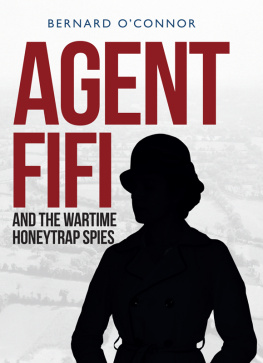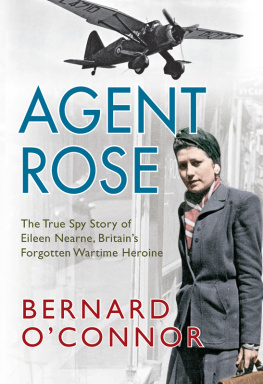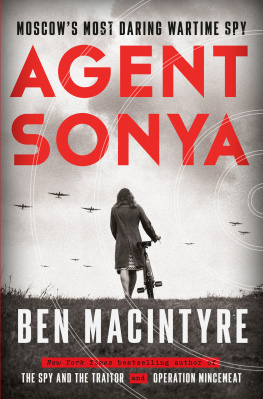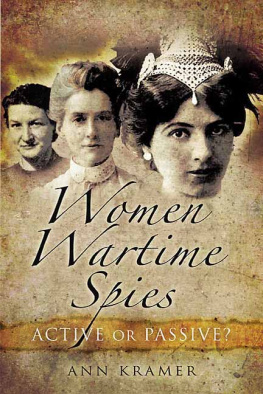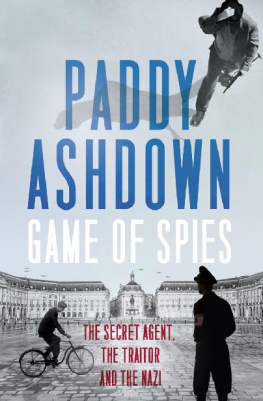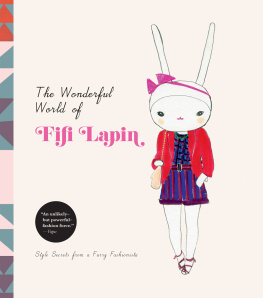Chilver Marie - Agent Fifi: and the wartime honeytrap spies
Here you can read online Chilver Marie - Agent Fifi: and the wartime honeytrap spies full text of the book (entire story) in english for free. Download pdf and epub, get meaning, cover and reviews about this ebook. City: Great Britain, year: 2015, publisher: Amberley Publishing, genre: Non-fiction. Description of the work, (preface) as well as reviews are available. Best literature library LitArk.com created for fans of good reading and offers a wide selection of genres:
Romance novel
Science fiction
Adventure
Detective
Science
History
Home and family
Prose
Art
Politics
Computer
Non-fiction
Religion
Business
Children
Humor
Choose a favorite category and find really read worthwhile books. Enjoy immersion in the world of imagination, feel the emotions of the characters or learn something new for yourself, make an fascinating discovery.
- Book:Agent Fifi: and the wartime honeytrap spies
- Author:
- Publisher:Amberley Publishing
- Genre:
- Year:2015
- City:Great Britain
- Rating:4 / 5
- Favourites:Add to favourites
- Your mark:
- 80
- 1
- 2
- 3
- 4
- 5
Agent Fifi: and the wartime honeytrap spies: summary, description and annotation
We offer to read an annotation, description, summary or preface (depends on what the author of the book "Agent Fifi: and the wartime honeytrap spies" wrote himself). If you haven't found the necessary information about the book — write in the comments, we will try to find it.
Agent Fifi: and the wartime honeytrap spies — read online for free the complete book (whole text) full work
Below is the text of the book, divided by pages. System saving the place of the last page read, allows you to conveniently read the book "Agent Fifi: and the wartime honeytrap spies" online for free, without having to search again every time where you left off. Put a bookmark, and you can go to the page where you finished reading at any time.
Font size:
Interval:
Bookmark:

First published 2015
Amberley Publishing
The Hill, Stroud
Gloucestershire, GL5 4EP
www.amberley-books.com
Copyright Bernard OConnor, 2015
The right of Bernard OConnor to be identified as the Author of this work has been asserted in accordance with the Copyrights, Designs and Patents Act 1988.
All rights reserved. No part of this book may be reprinted or reproduced or utilised in any form or by any electronic, mechanical or other means, now known or hereafter invented, including photocopying and recording, or in any information storage or retrieval system, without the permission in writing from the Publishers.
British Library Cataloguing in Publication Data.
A catalogue record for this book is available from the British Library.
ISBN 9781445646503 (PRINT)
ISBN 9781445646510 (eBOOK)
Typesetting and Origination by Amberley Publishing.
Printed in the UK
On 17 September 2014, I received an email from Steven Kippax, a historian who had set up a group for people interested in the Special Operations Executive (SOE), a top-secret organisation during the Second World War. He drew my attention to an article in The Telegraph entitled Revealed: identity of Fifi, the stunning wartime spy. It was about recently released documents in the National Archives in Kew that revealed previously unknown details about Fifi, an agent provocateur used by the SOE to test how willing the men and women they had trained to be secret agents were to divulge details about their training, their cover stories, their family background and their mission behind enemy lines.
I had previously researched and written numerous books about the agents training, their missions and RAF Tempsford, the secret airfield in Bedfordshire from where most were flown out on moonlit nights and dropped by parachute or landed in remote fields in occupied Europe. In most contemporary sources, the term agent provocatrice was used to stress the gender.
M. R. D. Foot, in his 1984 history of the SOE, mentioned them wanting to test the agents security while they were at their training schools and at safe flats in the West End of London in the intervals between training courses. Did they talk in their sleep, and if so in what language? There was a devastating blonde codenamed Fifi who made it her business to find out.
David Stafford, another SOE historian, commented that all the secretaries seemed to know about Fifi.
She was the Agent Provocatrice, gorgeous and enticing, who went all the way (at least for male trainees, what facilities there were for female trainees remains a mystery). Significantly, none of them actually met the legendry Fifi, nor has she ever surfaced with her story. Perhaps she has passed on, or now resides in south-coast respectability eager to forget her risqu past. More likely she never existed, her slinky seductress ways merely conjured up in Beaulieus ingenious minds as a dire warning to their students. This certainly, will be one SOE secrets never revealed.
Expecting widespread interest, Jonathan Cole created a blog for the National Archives website entitled Our Special Agent: Fifi and the Special Operations Executive. In it he stated that until Fifis file was released, she was considered a legend of SOE, a symbol of seduction not surprising, since shes said to have bedded trainee agents to find out whether they talked in their sleep.
The British media ran stories, including the Daily Mails Meet Agent Fifi, sent by British spymasters to test out trainee agents before they were sent to occupied Europe, the Independents Revealed after 75 years of secrecy: Fifi the glamorous WW2 special agent who tested British spies resolve and the Sunday Telegraphs Licensed to thrill: Christine Chilver, Britains Second World War special agent. I also found similar stories in the United States, Indian and Australian media.
I was able to download Fifis personnel file from the National Archives website and, using my background knowledge of SOE, the newspaper articles, contemporary biographies and other files in the National Archives, I have been able to piece together her story. While researching her story I found references to other agent provocateurs, female infiltrators and a number of double agents engaged in top secret deception operations. Their stories appear in the final chapters.
It has been rather like an archaeologist trying to find artefacts that shed light on a few years in the past, but in this case I have had to dig in different sites. The resulting account has understandable gaps in it and some pieces may have been wrongly placed, but I trust the story holds enough water to quench your thirst for knowledge about secret operations during the Second World War.
I need to acknowledge the research done by Mary Berbier, Glenda Cooper, Terry Crowdy, Barbara Davies, Patricia Grant, Ben Macintyre, Joan Miller, Clare Mulley, Noreen Riols, Anita Singh, Gregory Walton and Rayyan Sabet-Parry. I would like to thank David Armstrong, Trevor Butterworth, David Harrison, Fred Judge, Willem Mugge, Phil Tomaselli and Roger Tobbell who have been particularly helpful with background information on Britains intelligence services, the SOE in particular. Jim Cunningham kindly checked copies of Housewife magazine in the British Library. Special appreciation is given to Steven Kippax, a mine of information on SOE, who helped me to access personnel and other files in the National Archives in Kew. Jonathan Cole and the rest of the staff there need to be acknowledged for making the SOE files available and creating an online catalogue one can search from ones armchair. The Imperial War Museum in London and the Military Intelligence Museum in Chicksands also hold valuable records relating to the Intelligence Services. Paul Tonge very kindly provided photographs of Fifi.
Bernard OConnor, 2014
Documents in her personnel file in the National Archives in Kew, London, show that Marie Christine Chilver, known in her adult life as Christine, was born on 12 September 1920 in London, the daughter of a Latvian mother and the Times correspondent in Riga, the capital city of Latvia. Her father took over his father-in-laws timber business in Riga and, from 1920 to 1939, the family lived in a villa a few miles outside the city. Educated at home by French and English governesses, Christine also learned some German from a German maid. She saw little of her father as she was growing up as he spent a lot of his time in the office or away on business.
When she was twelve, her father took her and her governess to Tallin in Estonia and she spent the summer at Kuressaar. In September 1934, she spent a week in Stockholm with her father and, on returning from Sweden, her father rented a flat in Riga, where she attended a German school. When she was fifteen she was sent on her own to spend the summer of 1935 at a pension de famille, near La Lavandou on the Cte de Morts, to improve her French. She then spent another six months at school by which time her German was described as literal and colloquial. In spring 1936, she continued to study English and the following summer she went back to England and stayed as a paying guest with English families, first in Devon and then in London.
In spring 1938, she was sent to Paris to attend the Cours de la Civilisation Franaise at the Sorbonne. She returned to Riga at Christmas and was at home in September 1939 when Germany and the Union of Soviet Socialist Republics (USSR) used the secret Molotov-Ribbentrop Pact to invade Poland. At the end of November, the USSR invaded Finland. Fearing an attack on Latvia, her father decided to send her to England, where she prepared for the college entrance examination to read Modern Languages at Somerfield College, Oxford.
Font size:
Interval:
Bookmark:
Similar books «Agent Fifi: and the wartime honeytrap spies»
Look at similar books to Agent Fifi: and the wartime honeytrap spies. We have selected literature similar in name and meaning in the hope of providing readers with more options to find new, interesting, not yet read works.
Discussion, reviews of the book Agent Fifi: and the wartime honeytrap spies and just readers' own opinions. Leave your comments, write what you think about the work, its meaning or the main characters. Specify what exactly you liked and what you didn't like, and why you think so.

